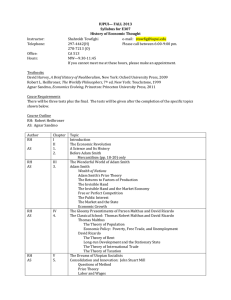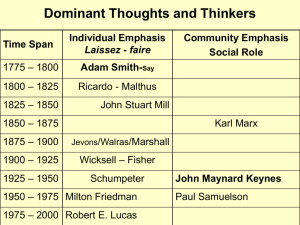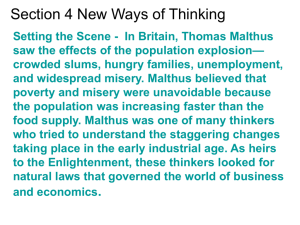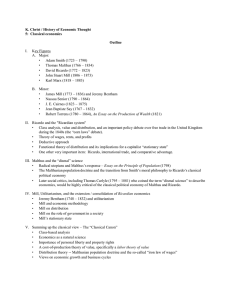(3) Interestingly enough, at least part of what Ricardo was
advertisement
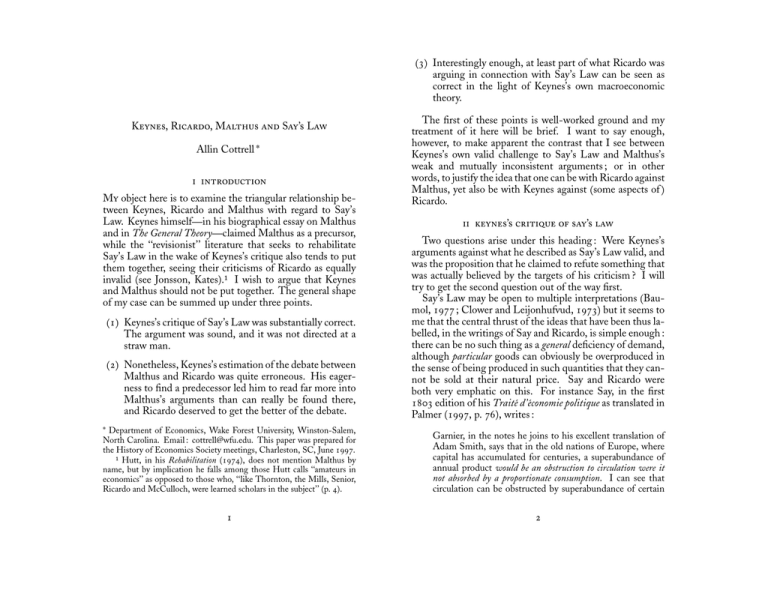
( 3) Interestingly enough, at least part of what Ricardo was arguing in connection with Say’s Law can be seen as correct in the light of Keynes’s own macroeconomic theory. Keynes, Ricardo, Malthus and Say’s Law Allin Cottrell * i introduction My object here is to examine the triangular relationship between Keynes, Ricardo and Malthus with regard to Say’s Law. Keynes himself—in his biographical essay on Malthus and in The General Theory—claimed Malthus as a precursor, while the ‘‘revisionist’’ literature that seeks to rehabilitate Say’s Law in the wake of Keynes’s critique also tends to put them together, seeing their criticisms of Ricardo as equally invalid (see Jonsson, Kates).¹ I wish to argue that Keynes and Malthus should not be put together. The general shape of my case can be summed up under three points. The first of these points is well-worked ground and my treatment of it here will be brief. I want to say enough, however, to make apparent the contrast that I see between Keynes’s own valid challenge to Say’s Law and Malthus’s weak and mutually inconsistent arguments ; or in other words, to justify the idea that one can be with Ricardo against Malthus, yet also be with Keynes against (some aspects of ) Ricardo. ii keynes’s critique of say’s law ( 2) Nonetheless, Keynes’s estimation of the debate between Malthus and Ricardo was quite erroneous. His eagerness to find a predecessor led him to read far more into Malthus’s arguments than can really be found there, and Ricardo deserved to get the better of the debate. Two questions arise under this heading : Were Keynes’s arguments against what he described as Say’s Law valid, and was the proposition that he claimed to refute something that was actually believed by the targets of his criticism ? I will try to get the second question out of the way first. Say’s Law may be open to multiple interpretations (Baumol, 1977 ; Clower and Leijonhufvud, 1973) but it seems to me that the central thrust of the ideas that have been thus labelled, in the writings of Say and Ricardo, is simple enough : there can be no such thing as a general deficiency of demand, although particular goods can obviously be overproduced in the sense of being produced in such quantities that they cannot be sold at their natural price. Say and Ricardo were both very emphatic on this. For instance Say, in the first 1803 edition of his Traité d’économie politique as translated in Palmer ( 1997, p. 76), writes : * Department of Economics, Wake Forest University, Winston-Salem, North Carolina. Email : cottrell@wfu.edu. This paper was prepared for the History of Economics Society meetings, Charleston, SC, June 1997. ¹ Hutt, in his Rehabilitation ( 1974), does not mention Malthus by name, but by implication he falls among those Hutt calls ‘‘amateurs in economics’’ as opposed to those who, ‘‘like Thornton, the Mills, Senior, Ricardo and McCulloch, were learned scholars in the subject’’ (p. 4). Garnier, in the notes he joins to his excellent translation of Adam Smith, says that in the old nations of Europe, where capital has accumulated for centuries, a superabundance of annual product would be an obstruction to circulation were it not absorbed by a proportionate consumption. I can see that circulation can be obstructed by superabundance of certain ( 1) Keynes’s critique of Say’s Law was substantially correct. The argument was sound, and it was not directed at a straw man. 1 2 products, but that can only be a passing evil, for people will soon cease to engage in a line of production whose products exceed the need for them and lose their value, and they will turn to the production of goods more in demand. But I do not see how the products of a nation in general can ever be too abundant, for each such product provides the means for purchasing another. In the same vein Ricardo writes in the Principles ( 1951, p. 290) : No man produces, but with a view to consume or sell, and he never sells, but with an intention to purchase some other commodity, which may be immediately useful to him, or which may contribute to future production. By producing, then, he necessarily becomes either the consumer of his own goods, or the purchaser and consumer of the goods of some other person. It is not to be supposed that he should, for any length of time, be ill-informed of the commodities which he can most advantageously produce, to attain the object which he has in view, namely, the possession of other goods ; and, therefore, it is not probable that he will continually produce a commodity for which there is no demand. Or, more pithily, ‘‘Too much of a particular commodity may be produced, of which there may be such a glut on the market, as not to repay the capital expended on it ; but this cannot be the case with respect to all commodities. . . ’’ ( 1951, p. 292). Keynes’s slogan—‘‘supply creates its own demand’’— seems no more than a convenient paraphrase of Ricardo’s ‘‘By producing, then, [a man] necessarily becomes either the consumer of his own goods, or the purchaser and consumer of the goods of some other person.’’ An even closer match is Ricardo’s assertion, in criticism of Malthus, that ‘‘demand depends only on supply’’ (Ricardo, 1951a, p. 365). I therefore don’t see the force of contrast in statements such as that of Kates ( 1997, p. 192) : ‘‘Since the publication of the General Theory the meaning of Say’s Law has radically shifted. The phrase which has become associated with Say’s Law 3 are the words introduced by Keynes, ‘supply creates its own demand’ ’’.² Although it is not central to my case here, I would also like to draw attention to my argument elsewhere (Cottrell, 1994) that Keynes was correct in attributing Say’s Law in this sense to his contemporary Pigou ; the latter’s Theory of Unemployment ( 1930) depends on this assumption at certain crucial points. And so to the validity of Keynes’s critique. Keynes has the volume of investment spending governed jointly by the schedule of the Marginal Efficiency of Capital and the rate of interest ; he also has the rate of interest governed jointly by the quantity of money available and the degree of liquidity preference, and the volume of consumption expenditure governed by consumers’ incomes via a fractional marginal propensity to consume. In this light consider the two ‘‘experiments’’ that Keynes treats as the most likely triggers of a deficiency of effective demand : a fall in the schedule of the Marginal Efficiency of Capital and an increase in the degree of liquidity preference. (The worst case is when they are conjoined, but they may be considered independently.) ( 1) A fall in the MEC schedule. This may occur for various reasons, such as the coming to an end of a period of rapid population growth or technological progress, or a politically determined shock such as the overvaluation of the national currency, as with Britain’s return to gold under Churchill. The question for upholders of Say’s Law is how a general fall in demand is to be averted. At a given rate of interest, the fall in the MEC schedule will generate a fall in investment, which will in turn, by reducing aggregate expenditure and income, generate a secondary fall in consumption (i.e. the multiplier). The only way to avert this result, it would seem, is for the rate of interest to fall immediately. Such a fall would ² On the next page Kates goes on to say that the ‘‘meaning of Say’s Law was further distorted in a 1942 paper by Oskar Lange’’ (emphasis added), underlining the idea that Keynes’s representation was already a distortion. 4 offset the incipient decline in investment, and might also (if the balance of the income and substitution effects is right) stimulate the propensity to consume to some degree. If the sum of these positives is great enough to counterbalance the initial negative effect on expenditure, then aggregate demand is maintained. Keynes’s point, however, is that a fall in the rate of interest of this degree cannot be expected. For as the interest rate goes down, the relative attractiveness of liquid, monetary assets vis-à-vis less liquid interest-bearing assets is increased. If the stock of money is presumed fixed, the interest rate— which does the job of balancing the desire to hold money with the available stock—is not free to fall.³ There is a secondary escape route for the re-establishment of the original level of aggregate demand in real terms, after a period of unemployment. That is, if money wages begin to fall in response to unemployment, and prices follow wages down, this increases the real stock of money, permitting a fall in the rate of interest. But Keynes argued that this scenario—which has come ironically to be known as the ‘‘Keynes effect’’—is only one among many possible consequences of general deflation, several of which are unfavourable to the expansion of aggregate demand (e.g. the expectation of further deflation, which raises the real rate of interest ex ante for any given nominal rate, the transfer of purchasing power from debtors to creditors, and the bankruptcy of those who borrowed at the earlier, higher prices—see Chapter 19 of the General Theory and Tobin, 1980). vious case). Again, the multiplier will lead to an amplified fall in aggregate demand. It is important to note that Keynes is not simply making the point that the hoarding of money brings a reduction in the aggregate demand for goods. That point, it could be argued, was well understood by the ‘‘classics’’, albeit as a theoretical limiting case of little practical significance. An increase in liquidity preference, in Keynes’s view, need not express itself in an actual transfer of money into idle hoards, or not on any large scale. Rather, the rate of interest is driven up to the point where the ‘‘propensity to hoard’’ (Keynes, 1936, p. 174) is balanced with the stock of money available for this purpose. The damage to aggregate demand is not done directly—the diversion of a stream of expenditure of money on goods, into a stream of money into coffers—but indirectly, via the depressing effect of high interest on investment. Consider this illustration. Let the initial ratio of annual income, Y , to the stock of money, M, be denoted by V . Let an initial fraction a of the money stock be employed in active circulation and the remainder, 1 − a, be held as ‘‘idle’’ balances. Now suppose that an increase in liquidity preference causes Y to fall by 4 percent. As a first approximation the requirement for active balances will also fall by 4 percent, leaving an amount .04aM to be absorbed into idle balances. Since M = Y/V we can write this increment to idle balances as .04aY/V ; as a fraction of initial Y this amounts to .04a/V . Illustrating with a = 0.9 and V = 5, the increase in idle balances is then only 0.72 percent of the initial Y . ( 2) The case of an increase in liquidity preference. Keynes’s argument here is straightforward : an increase in the desire to hold liquid money balances will force the rate of interest upward, hence depressing investment for any given location of the MEC schedule (and also depressing consumption, if it is interest-sensitive in the direction that would be helpful for the restoration of aggregate demand in the pre³ For an expansion of this point see Cottrell and Lawlor ( 1991). I don’t suppose I have said enough to convince anyone with a strong inclination to believe that Keynes’s critique of Say’s Law was misguided, but I hope I have said enough to bring out the point that this critique hinges on questions of interest and money. That is, it turns on the rejection of the idea—taken for granted by both Say and Ricardo— that money is held only in a fleeting transitional moment between the sale and purchase of goods, and consequently that economic analysis can legitimately proceed as if it were 5 6 dealing with a barter economy. iii ricardo versus malthus It is this dimension that is almost entirely missing from Malthus’s criticism of Say and Ricardo ; its absence means that his critique necessarily misses the mark, and that Keynes’s admiration for him is misplaced. The next section justifies the claim that Malthus missed the mark ; here I will put on the table Keynes’s assessment of him. Keynes’s remarks are to be found (mostly) in his biographical essay (in Keynes, 1963) and in chapters 3 and 23 of The General Theory. Of course Keynes is aware of shortcomings in Malthus ; he notes variously that the latter ‘‘was unable to explain clearly (apart from an appeal to the facts of common observation) how and why effective demand could be deficient or excessive’’, that he ‘‘failed to furnish an alternative construction’’ ( 1936, p. 32), and even that ‘‘Malthus’s defect lay in his overlooking entirely the part played by the rate of interest’’ ( 1963, p. 123). Nonetheless Keynes offered the judgment that in Malthus ‘‘the notion of the insufficiency of effective demand takes a definite place as a scientific explanation of unemployment’’ ( 1936, p. 362), and that Ricardo was ‘‘stone-deaf to what Malthus was saying’’ ( 363). Commenting on the Ricardo–Malthus correspondence he says ‘‘Malthus is dealing with the monetary economy in which we happen to live ; Ricardo with the abstraction of a neutral money economy’’ (Keynes, 1963, p. 116). ‘‘Time after time in these letters,’’ Keynes continues, ‘‘ Malthus is talking plain sense, the force of which Ricardo with his head in the clouds wholly fails to comprehend’’ ( 1963, pp. 117– 8). He further talks of ‘‘crushing refutations’’ by Malthus, and of Malthus’s ‘‘complete comprehension of the effects of excessive saving on output via its effects on profit’’ (ibid.). He speaks with strong approval of the chapter of Malthus’s Principles dealing with the role of unproductive consumers, and sighs ‘‘If only Malthus rather than Ricardo had been the parent stem from which nineteenth-century economics proceeded, what a much wiser and richer place the world would be to-day !’’ ( 1963, p. 120). I will argue that this is greatly overblown. The debate between these two writers was very extensive, including a voluminous personal correspondence over many years. For the modern reader, however, with the Sraffa– Dobb volumes to hand, the locus classicus is probably the parallel text of Malthus’s Principles—in large measure a critique of Say and Ricardo—and Ricardo’s commentary or rebuttal (Ricardo, 1951a). Although their disagreement over Say’s Law surfaces in numerous places, the most sustained discussions are found in Malthus’s chapter vii, ‘‘On the Immediate Causes of the Progress of Wealth,’’ and in particular sections iii and ix of that chapter (on accumulation and unproductive consumption respectively).⁴ Let us take the section on accumulation ‘‘as a Stimulus to the Increase of Wealth’’ first. Malthus begins by saying that ‘‘no permanent and continued increase of wealth can take place without a continued increase of capital’’ and that an ongoing increase of capital clearly requires saving, or the ‘‘conversion of revenue into capital’’. (In classical terminology the income of the capitalists becomes ‘‘revenue’’ if it spent on servants, luxuries or other articles of capitalist consumption, while it becomes ‘‘capital’’ if it is spent on the maintenance of productive labour, labour that produces commodities to be sold at profit.) But he quickly adds that accumulation, while basically beneficial, can be overdone : excessive parsimony will mean that the extra commodities produced will fail to find a market (at a price that covers cost, at any rate). 7 8 It is undoubtedly possible by parsimony to devote at once ⁴ Keynes also refers to Malthus’s chapter v section iv, ‘‘Remarks on Mr Ricardo’s Theory of Profits,’’ but I don’t find this to be very much to the point. In this section Malthus makes the argument that a change in wages will not necessarily leave total income unchanged (by causing an exactly offsetting change in profits). Ricardo actually agrees with that, but argues that the effects whereby a change in wages fails to generate an offsetting change in profits are second-order. Also, Malthus does not tie this point directly to his attack on Say’s Law. a much larger share than usual of the produce of a country to the maintenance of productive labour ; and it is quite true that the labourers so employed are consumers as well as unproductive labourers ; and as far as the labourers are concerned, there would be no diminution of consumption or demand. But . . . the consumption and demand occasioned by the persons employed in productive labour can never alone furnish a motive to the accumulation and employment of capital (in Ricardo, 1951a, pp. 301– 2, emphasis added). Aggregate consumption on the part of the labourers may remain constant as employment switches from unproductive to productive labour, says Malthus, but capitalist consumption falls ex hypothesi, which leads him to ask ‘‘how it is possible to suppose that the increased quantity of commodities, obtained by the increased number of productive labourers, should find purchasers. . . ’’ (p. 303). Note that this point, if it were correct, ‘‘proves too much’’. Malthus seems to suppose that aggregate demand is composed of just two elements, labourers’ consumption and capitalists’ consumption, and that accumulation in the first instance leaves the former unchanged while reducing the latter. But this means that any move toward increased accumulation is inevitably going to generate a glut of commodities, which surely can’t be right and is certainly not an argument that Keynes makes. In terms of Keynes’s conception of aggregate demand, of course, Malthus is leaving investment out of account. Malthus clearly recognizes that the point he has just made is in conflict with Say and Ricardo, according to whom, in Malthus’s paraphrase, ‘‘there cannot be a glut of commodities in general ; because . . . commodities being always exchanged for other commodities, one half will furnish a market for the other half.’’ This doctrine is ‘‘unfounded’’, claims Malthus : ‘‘It is by no means true . . . that commodities are always exchanged for commodities’’ (p. 307). The modern reader looks for a mention of money at this point, but that is not what Malthus has in mind : 9 The great mass of commodities is exchanged directly for labour, either productive or unproductive ; and it is quite obvious that this mass of commodities, compared with the labour with which it is to be exchanged, may fall in value from a glut just as any one commodity falls in value from an excess of supply. . . . (pp. 307– 8) Ricardo objects that in making this statement, Malthus has effectively switched the problem. The original problem was that accumulation was likely to give rise to a unsaleable surplus of commodities. But now it appears that the problem is really a labour shortage : the ‘‘mass of commodities’’ available for the payment of labour increases relative to the available supply of labour, so that the real wage increases and profit is squeezed. Now Ricardo has no problem with this as a theoretical possibility ; and it is quite consistent with Say’s Law. For reference it may be useful to spell out Ricardo’s ideas on how accumulation is self-limiting. There are two mechanisms here, operating on different time scales. At the level of the secular long run (as is well known), Ricardo envisaged diminishing returns in agriculture—due to the extension of the margin in face of the need to feed a larger population—and thought that this would put profits under a double squeeze from wages and rents. In the shorter run, however, if the size of the workforce were relatively fixed, then an increasing demand for labour would tend to drive up the wage independently of the agricultural mechanism, and again force profit down. Such a fall in profit would blunt the stimulus of gain and cause a slowdown of accumulation.⁵ Malthus’s point, it would seem, is none other than the latter. It is quite true that commodities may exist in such abundance, compared with labour, as to make their values so to fall, estimated in labour, as not to afford any inducement to their further production. . . . If Mr. Malthus means that there may be such a glut of commodities as to make them ruinously ⁵ Cf. Marx in Capital, i, ch. 25. 10 cheap in labour I agree with him, but this is only saying that labour is so high that it absorbs all that fund which ought to belong to profits, and therefore the capitalist will have no interest in continuing to accumulate. (Ricardo, 1951a, p. 308) As Ricardo further notes, the situation of the labourer will be far from miserable under these circumstances. Malthus goes on to press a second charge against Say and Ricardo, namely that they fail to take ‘‘into consideration the influence of so general and important a principle in human nature, as indolence or the love of ease’’ (p. 313). Specifically, he claims that the proposition that there can be no general shortage of demand, in the face of an increase in productive potential, rests on the assumption that ‘‘luxuries are always preferred to indolence. The effect of a preference of indolence to luxuries would evidently be to occasion a want of demand for the returns of the increased powers of production, and to throw labourers out of employment’’ (p. 313). Ricardo is able to make short work of this objection. Malthus has switched the problem again. Ricardo is happy to admit that there may come a point where leisure is preferred to further material consumption, but in that case the extra commodities will simply not be produced. We do not say the commodities will under all circumstances be produced, but if they are produced we contend there will always be some who have the will and power to consume them. . . . Men will prefer indolence to luxuries ! luxuries then will not be produced, because they cannot be produced without labour, the opposite of indolence. If not produced they cannot want a market, there can be no glut of them. (Ricardo, 1951a, pp. 314– 5) port an expanding workforce. Malthus considers this point, but objects that it would be no sort of use to the farmer to go cultivating his land with a view merely to give food and clothing to his labourers. He would be doing nothing either for himself or his family, if he neither consumed the surplus of what they produced himself, nor could realize it in a shape that might be transmitted to his descendants. (Ricardo, 1951a, pp. 318–9) This seems to be a central confusion in Malthus’s thinking, and Ricardo deftly exposes it (pp. 319– 21). Provided the supply of labour is elastic, the capitalist farmer will do very well by reinvesting his surplus in the maintenance of a progressively larger workforce. I am a farmer possessed of a thousand quarters of corn, and my object is to accumulate a fortune for my family. With this corn I can employ a certain number of men on the land, which I rent, and after paying my rent the first year, realize 1300 qrs., or 300 qrs. profit. The next year if there be plenty of labour in the market, I can employ a greater quantity than before, and my 1300 quarters will become 1700, and so from year to year I go on increasing the quantity till I have made it ten thousand quarters, and if labour be at the same price can command ten times the quantity of it that I could when I commenced my operations. Have I not then accumulated a fortune for my family ? have I not given them the power of employing labour in any way they please, and of enjoying the fruits of it ? One further point in this section merits attention. If the capitalists take a turn towards parsimony then it may well be that the market for luxuries contracts. Ricardo’s point is then that some other market should expand accordingly— specifically, more ‘‘necessaries’’ should be produced to sup- The only obstacles here are those that Ricardo has already recognized, namely ‘‘an increase in the price of labour, or a diminution in the productive powers of the land.’’ Indeed, from a Keynesian perspective it is hard to see what could go wrong, in terms of effective demand, in this sort of barter of the products of the land for labour services. As we said above, only the introduction of money, conceived as something other than a mere means of circulation, can 11 12 create a problem here—and there is no money in Malthus’s argument.⁶ Some additional insight into the debate between Malthus and Ricardo can be gained by considering Malthus’s case for the necessity of ‘‘unproductive consumers’’ as a ballast for the thrift of the capitalists (ch. vii, sec. ix of his Principles). Ricardo is incredulous ; from his point of view unproductive consumers are ‘‘just as necessary and as useful with a view to future production, as a fire, which should consume in the manufacturers warehouse the goods which those unproductive labourers would otherwise consume’’ (Ricardo, 1951a, p. 421). Insofar as Malthus’s proposal involves an increase in government expenditure—the paradigmatic ‘‘unproductive labourer’’ is apparently a state functionary—it may be tempting to assimilate it to modern Keynesian ideas concerning fiscal policy. But this would be a mistake. We should note that Malthus recommends an increase in taxation to finance the payments to the unproductive consumers (Ricardo, 1951a, p. 433). The main point of interest in this section is the implied contrast between (a) the capitalist’s laying out his surplus in the form of payment of wages to additional labourers—a course which, as we have seen, Malthus claimed was ‘‘no sort of use’’ in the pursuit of augmented wealth for the capitalist or his posterity—and (b) the appropriation of this surplus in the form of taxation, with the proceeds being passed, to put in bluntly, to a class of respectable parasites. Point (a) comes up again in this section when Malthus says ‘‘nobody will ever employ capital merely for the sake of the demand occasioned by those who work for him’’ (Ricardo, 1951a, p. 429). But somehow it is all right if the demand comes from those who produce nothing. The only rationale for preferring consumption on the part of unproductive labourers, it would seem, is precisely that the latter are unproductive—i.e. they do not contribute to the production of a problematic surplus of commodities. This bespeaks a curious sort of ‘‘physical overproduction’’ theory on Malthus’s part, which is not to be found in Keynes.⁷ Ricardo’s question seems well put : ‘‘In what way can a man’s consuming my produce, without making me any return whatever, enable me to make a fortune ? I should think my fortune would be more likely to be made, if the consumer of my produce returned me an equivalent value’’ (Ricardo, 1951a, p. 422).⁸ Also in this section Ricardo diagnoses what he sees as a key inconsistency in Malthus’s reasoning. Malthus says that, absent the unproductive consumers, too rapid an accumulation may lead to a situation where ‘‘both capital and population may be at the same time, and for a period of great length, redundant, compared with the effective demand for produce’’ (Ricardo, 1951a, p. 427). Ricardo replies : ‘‘It is a contradiction in terms, it is saying that there is a capital unemployed because its owner cannot find labourers, and there are people unemployed because there is no one having a capital to employ them’’ (ibid.). So long as money is held ⁶ That is, I agree with Sowell ( 1972, p. 96) when he says that, pace Keynes, Malthus’s analysis was in essence ‘‘as nonmonetary as that of the supporters of Say’s Law.’’ The nearest Malthus comes to bringing money into the Principles is an extended footnote (Ricardo, 1951a, pp. 316– 7) urging its importance ; but this insight is not integrated into his analysis in any way. ⁷ Somewhat notoriously perhaps, Keynes held that even totally unproductive activities (e.g. burying pound notes and then digging them up again) would be useful for stimulating a depressed economy, if they were financed by deficit spending. He did not, however, make any virtue of the unproductive nature of this activity, remarking that it ‘‘would, indeed, be more sensible to build houses and the like’’ (Keynes, 1936, p. 129). ⁸ As Kalecki ( 1954) showed, the aggregate (money) profits flowing to the capitalists are composed of capitalist expenditure (consumption and investment) plus the government’s budget deficit, plus the export surplus in an open economy, minus any saving made by the workers out of their wages. From this (admittedly anachronistic) perspective there is no stimulus to profit from a tax-financed increase in government transfer payments ; the effect on profit is negative if the taxation displaces capitalist expenditure. I mention this point only to reinforce Ricardo’s skepticism from a different point of view. 13 14 out of the picture—and, once again, Malthus does not bring it in—Ricardo’s argument seems unanswerable. If produce commands labour and labour buys produce, where can the blockage arise ? iv ricardo on smith In the previous section I argued that Malthus’s criticism of Ricardo and Say misfires. Here I wish briefly to make the point that the invocation of Say’s Law in Ricardo’s own Principles of Political Economy and Taxation—in ch. xxi, ‘‘Effects of Accumulation on Profits and Interest’’—turns out to play a particular and unexpected role. Ricardo invokes Say in the course of an argument that one might almost call Keynesian : that investment ‘‘justifies itself ’’ (in the aggregate) by creating a demand for its product. Although I don’t wish to push the point too far, this is somewhat akin to Keynes’s multiplier. The argument in question begins from a critique of Adam Smith, who, as Ricardo says, ‘‘uniformly ascribes the fall of profits to accumulation of capital, and to the competition which will result from it.’’ Quoting from Smith, Ricardo continues thus : ‘‘The increase of stock,’’ he says, ‘‘which raises wages, tends to lower profit. When the stocks of many rich merchants are turned into the same trade, their mutual competition naturally tends to lower its profit ; and when there is a like increase of stock in all the different trades carried on in the same society, the same competition must produce the same effect in all.’’ Adam Smith speaks here of a rise in wages, but it is of a temporary rise, proceeding from increased funds before the population is increased ; and he does not appear to see, that at the same time that capital is increased, the work to be effected by capital, is increased in the same proportion. M. Say has, however, most satisfactorily shewn, that there is no amount of capital which may not be employed in a country, because demand is only limited by production. (Ricardo, 1951, pp. 289–90) 15 Against Smith’s idea that the ‘‘mutual competition’’ of capitals of itself lowers the aggregate profit, Ricardo asserts that there is no limit to demand—no limit to the employment of capital while it yields any profit, and that however abundant capital may become, there is no other adequate reason for a fall of profit but a rise of wages, and further it may be added, that the only adequate and permanent cause for the rise of wages is the increasing difficulty of providing food and necessaries for the increasing number of workmen. (op. cit., p. 296) What exactly is Ricardo arguing here ? I take it he is objecting to the unwarranted projection of a microeconomic conception onto the macro level—which itself sounds rather Keynesian. He would agree, of course, that any particular commodity may be produced to the point where it becomes unprofitable : the market becomes saturated and the price falls. But, pace Smith, it is a mistake to suppose that the same mechanism operates at the macro level.⁹ Why ? Although Ricardo does not spell it out in this way, I think we may say the following. When we consider the effects of the expansion of production of some commodity X we are doing partial equilibrium analysis : we are supposing that the demand schedule for the commodity in question is given, and that increased production moves us out along the given demand curve. In that case increased production means reduced profitability. But when we consider the effects of accumulation in general such a ceteris paribus assumption is untenable. An economy-wide increase in investment inevitably pushes demand schedules outward. This point is consonant with Keynes’s analysis (the multiplier means that an increase in investment gives rise to an increase in aggregate demand greater than the initial increment to investment). ⁹ This is expressed particularly clearly in Ricardo ( 1951a, p. 132), when he says that ‘‘no mistake can be greater’’ than the supposition ‘‘that a fall in profits is a necessary consequence of an accumulation of capital.’’ 16 Ricardo says that accumulation is limited only by profitability. With this Keynes could agree : in his theory investment is not limited by demand ; rather investment itself constitutes the proximate limit on demand, via the multiplier. Where the two part company, however, is over Ricardo’s further claim that the only serious restriction on the profitability of investment lies in diminishing returns in agriculture. For Keynes the profitability of real investment is the combined effect of the level of the schedule of the marginal efficiency of capital and the money rate of interest, where the latter has a ‘‘life of its own’’ and is not merely a reflection of a pregiven level of real profitability. Keynesian unemployment arises when the configuration of the MEC schedule and the rate of interest is such that the resulting level of investment falls short of the saving that would be generated out of the full-employment level of income. It’s not that investment is limited by demand, as in Smith and Malthus : production is limited by demand, but this is because the rate of interest is too high to generate a volume of investment that corresponds to full-employment saving. discern in Malthus’s erroneous and incoherent objections to Say’s Law the outline of the quite different critique that was to be advanced by Keynes himself over a century later. That is asking too much ! references The Malthus–Ricardo debate was essentially conducted on the terrain of a barter economy ; and on this terrain there can be little doubt that Ricardo was right. Keynes said he wished that Malthus had won the debate with Ricardo. But as the debate actually played out, had Malthus been perceived as the victor this would simply have reflected badly on the logical acumen of the audience. Keynes’s critique of Say’s Law depends essentially—as the title of his book reminds us—on issues of interest and money ; these were not in play in Malthus, and it is only with Keynesian hindsight, and with a large benefit of the doubt, that Malthus can be credited with real insight. ‘‘Surely it was a great fault in Ricardo to fail to see any significance in [Malthus’s] line of thought,’’ wrote Keynes ( 1963, p. 123). But what Keynes is really saying, it seems to me, is that he wishes Ricardo had been able to Baumol, W. 1977. ‘‘Say’s (at Least) Eight Laws, or What Say and James Mill May Really Have Meant’’. Economica, May, pp. 145–61. Clower, R. W. and A. Leijonhufvud 1973. ‘‘Say’s Principle, What It Means and Doesn’t Mean’’. Intermountain Economic Review, Fall. Reprinted in A. Leijonhufvud, Information and Coordination. New York : Oxford University Press, 1981. Cottrell, A. 1994. ‘‘Keynes’s Appendix to Chapter 19 : A Reader’s Guide’’. History of Political Economy 26 :4, pp. 681–95. and M. S. Lawlor 1991. ‘‘ ‘Natural Rate’ Mutations : Keynes, Leijonhufvud and the Wicksell Connection’’. History of Political Economy 23 :4, pp. 625–43. Hutt, W. H. 1974. A Rehabilitation of Say’s Law. Athens, OH : Ohio University Press. Jonsson, P. O. 1997. ‘‘On Gluts, Effective Demand and the True Meaning of Say’s Law’’. Eastern Economic Journal (forthcoming). Kalecki, M. 1954. ‘‘The Determinants of Profits’’. In his Theory of Economic Dynamics. London : George Allen and Unwin. Kates, S. 1997. ‘‘On the True Meaning of Say’s Law’’. Eastern Economic Journal (forthcoming). Keynes, J. M. 1936. The General Theory of Employment, Interest and Money. London : Macmillan. . 1963. Essays in Biography. New York : Norton. Marx, K. 1976. Capital, volume i, Harmondsworth : Penguin. 17 18 v conclusion Palmer, R. R. 1997. J.-B. Say. Princeton, NJ : Princeton University Press. Pigou, A. C. 1930. The Theory of Unemployment. London : Macmillan. Ricardo, D. 1951. Principles of Political Economy and Taxation. The Works and Correspondence of David Ricardo, Volume i. Edited by P. Sraffa with the collaboration of M. H. Dobb. Cambridge : Cambridge University Press. . 1951a. Notes on Malthus’s Principles of Political Economy. The Works and Correspondence of David Ricardo, Volume ii. Edited by P. Sraffa with the collaboration of M. H. Dobb. Cambridge : Cambridge University Press. Sowell, T. 1972. Say’s Law, An Historical Analysis. Princeton, NJ : Princeton University Press. Tobin, J. 1980. Asset Accumulation and Economic Activity. Oxford : Basil Blackwell. 19 20
